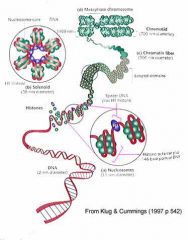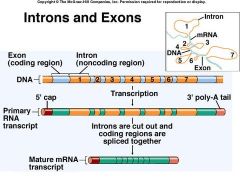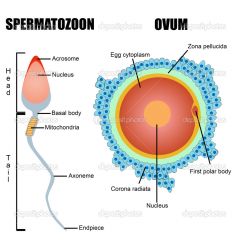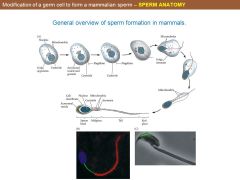![]()
![]()
![]()
Use LEFT and RIGHT arrow keys to navigate between flashcards;
Use UP and DOWN arrow keys to flip the card;
H to show hint;
A reads text to speech;
65 Cards in this Set
- Front
- Back
|
Fertlization |
fusion of male and female gametes to form a zygote |
|
|
Embryology |
is the branch of biology that studies the development of gametes |
|
|
Major approaches to embrology |
anatomical: distinguish parts experimental genetic |
|
|
Levels of Organization |
Cells, tissues, organs, organ system, organism, community, population, ecosystem |
|
|
Meiosis |
DNA replication that is followed by two rounds of cell division to produce four daughter cells; each with half the number of chromosomes as the original parent cell. (sex cells) |
|
|
Comparative embrology |
Aristotle studying various animal birth methods Oviparity: from eggs Viviparity: live birth Ovoviviparity: egg that hatches inside body |
|
|
Epigenesis vs. Preformation |
Epigenesis: the process by which plants/ animals/fungi develop from a seed through a sequence of steps in which cells differentiate and organs form Preformation: the adult organism that develops from it, is preformed in the sex cells |
|
|
Primary Germ Layers |
Ectoderm: outer layer (epidermis of skin, CNS melanocyte) Mesoderm: middle layer (notochord, head, RBC, bone tissue, facial mucsles) Endoderm: internal layer (stomach cells, thryoid cells, lung cells) |
|
|
Fate Maps |
use cell labeling techniques to trace cell lineages |
|
|
Labeling Techniques |
-individual cells are labeled and followed to see what they become(groups too) 1. host embryo sectioned for microscopy 2. radioactive cells are descendants of the graft and distinguished by auto-radiography -radioactive, fluorescent, vital dye staining, genetic marking |
|
|
Evolutionary Embryology |
-Charles Darwin noted embryonic resemblances and correlated different animal groups. -"Community of decent"- origin of species |
|
|
Embryonic Homologies |
homologous: structures that look alike due to common ancestry analogous: structures that look alike due to similar function |
|
|
Medical Embryology |
using the information known about human embryos to predict genetic abnormalities, birth defects, malformations and mutations. |
|
|
Teratology |
the study of disruptions or abnormalities caused by extraneous agents (chemicals, viruses, radiation) that disrupt normal development |
|
|
Chromosomal Sex Determination |
Mammals; presence or absence of X or Y birds; male= ZZ female=ZW fruit fly; X=male XX=female XXAAA=mosaic humans; XX= female XY=male |
|
|
Primary Sex Determination (mammals) |
determination of ovaries( female) and testes (male); relates to chromosomes |
|
|
Secondary Sex Determination |
sexual phenotype as well a hormones and paracrine factors XX-female XY-male XXXXY-male XO-female |
|
|
Sex Determination in Drosophila |
In Drosophila, sex determination is achieved by a balance of female determinants on the X chromosome and male determinants on the autosomes. X:AA=male XX:AA=female XO:AA=sterile male |
|
|
Environmental Sex Determination |
Alligators; eggs <30C=female & >34C=male Bonellia Viridis; larva on the sea floor=female & larva on the female's proboscis=male |
|
|
Phenotypic Plasticity |
the ability of an organism to react to environmental factors by changing form, state of activity or movement. |
|
|
Norm of Reaction |
a genome encoding for a continuous range of possible phenotypes |
|
|
morphs |
different phenotypes produced by the environmental conditions |
|
|
polyphenism |
discontinuous phenotypes elicited by the environment |
|
|
Diet and DNA Induced Methylation |
changes that occur in phenotypes -a diet rich in methyl donors (5-methyl-cytosine) resulted in health mice with black fur -with out methylation the mice were yellow and fat |
|
|
Life Cycle of Slime Mold |
spore, germinating spore, amoeboid cell (flagellated), feeding plasmodium, fruiting body, spoorangium |
|
|
Developmental Symbiosis |
Parasitism: 1 partner benefits Mutualism: both partners benefit Commensalism: 1 partner benefits the other neutral |
|
|
Regulation of Gene Expression |
Differential: regulates nuclear gene transcription into RNA Selective Nuclear RNA Processing: determines which of the transcribed RNA will enter cytoplasm>mRNA Selective mRNA Translation: regulate translation of genetic info>mRNA>proteins Differential Protein Modification: determine which proteins remain and function in the cell |
|
|
Evidence for Genomic Equivalence |
polytene chromosomes; DNA replication w/out separation -frog blastula cell nuclei directed the complete development of somatic cells>tadpoles |
|
|
Cloning |
the process of producing similar populations of genetically identical individuals via somatic nuclear transfer that occurs in nature when organisms such as bacteria, insects or plants reproduce asexually. |
|
|
Polymerase Chain Reaction |
Denaturation: seperation of DNA strands(>90C) Annealing: slow cooling for primer hybrid. Extension: repeating step1&2 w/ thermal stable enzyme (Taq) |
|
|
Dolly the Sheep |
egg and cell fused with electric current>embryo cultured for 7 days>embryo transferred to surrogate mother>Dolly |
|
|
Differential Gene Transcription |
This H1-dependent conformation of nucleosomes inhibits the transcription of genes in somatic cells by packing adjacent nucleosomes together into tight arrays that prohibit the access of transcription factors and RNA polymerases to the genes |
|
|
Anatomy of the gene |

|
|
|
Introns and Exons
|

|
|
|
Promoter Region |
transcription start site that contains sequences that are bound by RNA polymerase
|
|
|
Transcription Iniation |
binding of RNA polymerase to double-stranded DNA; this step involves a transition to single-strandedness in the region of binding; RNA polymerase binds at a sequence of DNA called the promoter.Transcription |
|
|
Translation Initiation |
mRNA+initiator tRNA+ribosomal subunits= complex to start translation |
|
|
Promoters |
located near the transcription start sites of genes, on the same strand and upstream on the DNA (towards the 5' regionof the sense strand) -start transcription -sequence called TATA Box(flanked by CpG islands) |
|
|
Enhancers |
a DNA sequence that controls the efficiency and rate of transcription of a specific promoter |
|
|
Transcription Factors |
proteins that bind to enhancers or promoter regions and interact to activate or repress transcription of a particular gene |
|
|
Transcription Factor Domains |
DNA Binding Domain: ID and binds a particular DNA sequence Trans-activating Domain: activates or suppresses the transcription of the gene its bound to Protein Protein Interaction Domain: allows transcription factor activity to be modulated by proteins and other transcription factors |
|
|
DNA Methylation |
promoters of inactive genes become methylated at some cytosine residues and thus stabilizes nucleosomes, preventing transcription factors from binding DNA -can only methylate if they are flanked by CpG islands -transcription regulation method |
|
|
Consequences of DNA Methylation |
Genomic Imprinting: genes being active in early embryo; coming from egg or sperm X-Inactivation: doubling the rate of transcription in the single male X-chromosome>makes the same# of transcripts as female(dosage compensation)>inactivation of one X-chromosome(for females) |
|
|
RNA Processing |
To become an active protein, the RNA must be (1) processed into a messenger RNA by the removal of introns, (2) translocated from the nucleus to the cytoplasm, and (3) translated by the protein-synthesizing apparatus. In some cases, the synthesized protein is not in its mature form and (4) must be posttranslationally modified to become active. -longer life of mRNA> more proteins translated from it depends on length of poly A tail on 3' end |
|
|
Cell Adhesion |
cells interact and attach to a surface, substrate or anothercell, mediated by interactions between molecules of the cell surface. |
|
|
Cadherins |
Type-1 transmembrane proteins that play important roles in cell adhesion, forming adherens junctions to bind cells within tissues together. -They are dependent on calcium (Ca2+) ions to function, hence their name. |
|
|
Induction |
interaction at close range between 2+ cells/tissues of different histories and properties |
|
|
Competence |
ability to respond to a specific signal |
|
|
Induction Cascade |
loigand initiation to extracellular domain>conformation change in receptors structure>cytoplasmic change>enzymatic activity (kinase)>phosphorylation>activation of transcription factor or cytoskelatal protein |
|
|
Paracrine Factors |
When proteins synthesized by one cell can diffuse over small distances to induce changes in neighboring cells |
|
|
Juxtacrine Interactions |
cell membrane proteins on one cell surface interact with receptor proteins on adjacent cell surfaces |
|
|
Endocrine Factors |
hormones travel through the blood to exert their effects |
|
|
Autocrine Regulation |
the same cells that secrete paracrine factors also respond to them |
|
|
Cell Death Pathways |
In Mammals Bc12>Apaf1>Caspase-9>Caspase-3>Apoptosis In Nematodes EGL-1>CED-9>CED-4>CED-3>Apoptosis |
|
|
Extracellular Matrix as Source of Developmental Signals |
has macromolucules secreted by cells into immediate envrionment that form a region of non-cellular material spaces between cells>attachment sites for cells>permissive substrate for cell adhesion, migration and formation of epithelial sheets |
|
|
Integrins |
receptors for extracellular matrix molecules; integrate extracellular and intracellular proteins for team work |
|
|
Structure of Gametes |

|
|
|
Germ to Sperm |

|
|
|
Recognition of Sperm and Egg |
Chemoattractioin: egg secretes soluble molecules for the sperm Exocytosis: acrosomal vesicle releases enzymes Binding: sperm attaches to vitelline(extracellular matrix) of egg Passage: sperm passes through vitelline Fusion of egg and sperm |
|
|
Sea Urchin Fertilization |
the eggs shed or secrete small peptides such as resact that act as chemotactic factors for the sperm>the sperm sense the pH gradient (and peptide)and move toward it>sperm come in contact with egg jelly>acrosome reaction>fusion |
|
|
Acrosome reaction |
fusion of the acrosomal vesicle with the sperm cell membrane and extansion of the acrosomal process |
|
|
Fusion of Egg and Sperm Membrane |
protein mediated: polymerization of actin molecules>fertilization cone >actin from sperm and egg from bridge for nucleus bindin found in the sperm |
|
|
Prevention of Polyspermy |
Fast Block: cytoplasm of oocyte has <Na and K+ is inside, the resting membrane potential increases when binding occurs> the influx has to be +20 (fusion happens when the resting membrane potential is stable) 1-3 sec Slow Block: removel of sperm bound to vitilline membrane by cortical granule rxn cause by increase in Ca2+ 1 min |
|
|
Cell Commitmet |
Labile Specification: differentiate autonomously in neutral environment(reversible) Determined: diifferentiate in another region of embryo (irreversible) |
|
|
Modes of Cell Commitment |
Autonomous: mosaic embryogenesis (develop on its on depending on origin) Conditional: cell specific condition (neighboring cells) Syncytial: different parts of the same cell |

